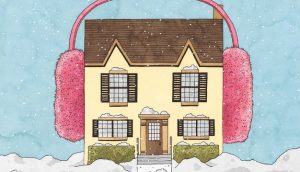As the last leaves fall, temperatures grow cooler and daylight shorter, many homeowners start to think about  winterization and protecting their homes and yards for the coldest months of the year.
winterization and protecting their homes and yards for the coldest months of the year.
While each home has specific winterization needs, the Lebanon Utilities team has pulled together a helpful list to assist area homeowners with checking their properties and preparing for winter. As a rule of thumb start outside, move to under your home and then inside your home.
Outside:
- Remove all hoses and hose bibs. Drain hoses before storing for the winter.
- Turn off timed irrigation systems, as well as valves to the irrigation systems.
- Turn off any valves to outdoor fountains or water features.
- Insulate any exposed pipes and outside faucets.
- Cover outside vents near the foundation.
- Clean out gutters from any leaves or debris.
- Spot check your roof for any loose shingles or problem areas.
- Buy sidewalk salt ahead to be prepared for icy weather.
Under Your Home:
- Close all vents that were opened for summer.
- Make sure all water lines (both hot and cold) are wrapped in pipe insulation.
- Any water lines near open areas should have heat tape on the underside of the pipe insulation. Be sure to follow the manufacturer’s instructions.
Garage Areas:
- Make sure all water lines (both hot and cold) are wrapped in pipe insulation.
- Any water lines near open areas should have heat tape on the underside of the pipe insulation. Be sure to follow the manufacturer’s instructions.
- If your water heater is in the garage, do not turn it down to low or off when leaving for vacation. It will freeze without heat.
- However, if your washer is in the garage, do turn the water off when not using it.
Inside:
- Check around doors, windows, outlets and vents for air leaks. Add caulk or weather strip.
- Insulate pipes running through attics, crawl spaces or exterior walls.
- Turn your furnace on and make sure it is working properly. Scheduling service if needed.
- Replace your furnace’s air filter. A dirty filter means your furnace has to work harder.
- Check attics, basements and crawlspaces for any insulation needs.
- Change the direction of ceiling fans. Clockwise rotation produces warmer air.
- Install a storm door. It can help seal drafts and reduce air flow.
- Control temperatures with a programmable thermostat.
- Remove and store A/C units if possible.
The above list was developed as a helpful guide for homeowners. It may not be a complete list for your specific home. To have easy access to the list as you do your winterization walk around inspection, download here.

Recent Comments